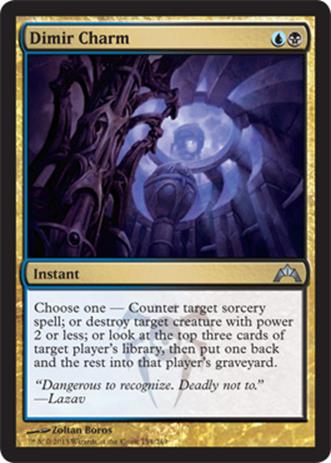
And I think that’s about it. Frown town.
Ok, ok, we’ll be a little more thorough, but unlike Return to Ravnica there are no format defining cards like Deathrite Shaman, staple cards like Abrupt Decay, or even powerful sideboard options like Rest in Peace. Instead we have a number of niche cards that are unlike to make the cut, the Nivmagus Elementals and Worldspine Wurms of this set. The potential Legacy cards in Gatecrash can roughly be divided into four categories: flexible cards that fit in existing archetypes, powerful cards that currently do not have a home, cards that only fit in a single archetype, and sideboard cards. Let’s walk through them:
Flexible currently playable cards
 Dimir Charm is a lot like Izzet Charm – it kills a bunch of relevant creatures (Dark Confidant, unflipped Delvers, Deathrite Shaman, Elves, utility creatures), can counter relevant spells in all of the combo and most of the control decks, and has a marginal card filtering ability that can be used in a pinch. I think it’s a lot more likely to see play than Izzet Charm, however, because it is a better fit for the BUG decks than Izzet Charm was for RUG Delver and it shores up their weaknesses whereas Izzet Charm addressed issues that weren’t pressing for RUG Delver. Specifically, a 2cc reactive spell is much more palatable to BUG decks that run more lands, have Deathrite Shamans, and want to play a longer game than in the mana light RUG Delver decks. RUG decks didn’t need the flexibility of Izzet Charm because they use burn spells for removal, meaning that they don’t have to worry as much about their removal spells being dead in combo matchups, whereas BUG decks will appreciate having removal that doubles as a counterspell more. Additionally the disruption that Dimir Charm gives BUG decks is a better compliment to its existing suite of disruption, because it attacks from a different angle than the discard that BUG relies upon. I think that Dimir Charm has enough things going for it that it should see some maindeck usage in BUG decks.
Dimir Charm is a lot like Izzet Charm – it kills a bunch of relevant creatures (Dark Confidant, unflipped Delvers, Deathrite Shaman, Elves, utility creatures), can counter relevant spells in all of the combo and most of the control decks, and has a marginal card filtering ability that can be used in a pinch. I think it’s a lot more likely to see play than Izzet Charm, however, because it is a better fit for the BUG decks than Izzet Charm was for RUG Delver and it shores up their weaknesses whereas Izzet Charm addressed issues that weren’t pressing for RUG Delver. Specifically, a 2cc reactive spell is much more palatable to BUG decks that run more lands, have Deathrite Shamans, and want to play a longer game than in the mana light RUG Delver decks. RUG decks didn’t need the flexibility of Izzet Charm because they use burn spells for removal, meaning that they don’t have to worry as much about their removal spells being dead in combo matchups, whereas BUG decks will appreciate having removal that doubles as a counterspell more. Additionally the disruption that Dimir Charm gives BUG decks is a better compliment to its existing suite of disruption, because it attacks from a different angle than the discard that BUG relies upon. I think that Dimir Charm has enough things going for it that it should see some maindeck usage in BUG decks.
 Orzhov Charm could see some play in Junk decks if we ever move to a point in the format where a Maverick deck splashing black became a viable choice again. A deck would have to want the third mode to be significantly useful in order to choose to play Orzhov charm, since the first mode is mostly useless and the second mode has to compete with Swords to Plowshares. Realistically the only 1 drops I would be willing to pay 2 mana to reanimate are Deathrite Shaman, Mother of Runes, and Heritage Druid/Nettle Sentinel/Wirewood Symbiote/etc. I’d want at least eight creatures I could get back in order to run this card, so either I’m looking at a combo Elves deck or a Maverick deck to play this. Unfortunately Maverick is not playable in the current meta and I think trying to play a double splash non-creature card in Elves is pretty ambitious.
Orzhov Charm could see some play in Junk decks if we ever move to a point in the format where a Maverick deck splashing black became a viable choice again. A deck would have to want the third mode to be significantly useful in order to choose to play Orzhov charm, since the first mode is mostly useless and the second mode has to compete with Swords to Plowshares. Realistically the only 1 drops I would be willing to pay 2 mana to reanimate are Deathrite Shaman, Mother of Runes, and Heritage Druid/Nettle Sentinel/Wirewood Symbiote/etc. I’d want at least eight creatures I could get back in order to run this card, so either I’m looking at a combo Elves deck or a Maverick deck to play this. Unfortunately Maverick is not playable in the current meta and I think trying to play a double splash non-creature card in Elves is pretty ambitious.
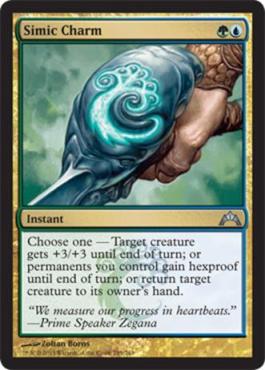
I’ve heard arguments that Simic Charm is a card that RUG Delver decks would want, but I’m skeptical. I’d argue that Vapor Snag is a better card than Simic Charm if you’re in the market for an Unsummon, as two mana is much more than one mana in the sort of tempo decks that want an Unsummon and bouncing your own creature is almost as good a defensive measure as giving your guy Hexproof. Simic charm has the nice upsides of countering an opponent’s Wasteland activation and winning Tarmogoyf wars, but you’ll rarely realize the former since you would be leaving up two mana and you already have burn spells to realize the latter. Simic Charm just doesn’t match up well to with RUG Delver’s plan of attack.
Powerful cards without a home


Twitter’s been all aflutter with Boros Charm ever since it was spoiled, and with good reason – it’s a sweet card. Boros Charm is a great card for aggressive creature based decks that either have a few key creatures they want to protect or which exist in a format where Wrath effects are prevalent. Unfortunately there aren’t any viable decks in Legacy that would want Boros Charm and Boros Charm doesn’t match up well to the removal in the format. The first issue is that there aren’t any red white decks in Legacy anymore – ever since the demise of Zoo this color combination has been virtually non-existent as these two colors have been relegated, in creature decks, to splash colors that are both splashed primarily for removal (and thus are never splashed together). Neither of the two relevant red decks in the format, Burn and Goblins, would want to splash White for this card as only one of the modes is relevant to either deck (Burn is interested in dealing damage and Goblins is interested in indestructability) and splashing an additional color is a real cost for both decks. Maverick might have been interested in splashing Boros charm, but, as mentioned previously Maverick isn’t a deck currently, and if it were to become more viable it would be more interested in splashing black for disruption than red for Punishing Fire and Boros Charm. In addition to not having a deck that wants these abilities, Boros Charm simply doesn’t match-up well with the format right now. The third ability is only relevant in creature combat, as you’re rarely going to deal more than 4 additional damage to an opponent by giving a creature double strike, particularly in the fast aggressive decks that want the other abilities. Four damage for two mana is actually a pretty good deal, but the granting indestructibility to your permanents isn’t as relevant as we would like given that the only Wrath in the format is Terminus and that Swords to Plowshares and Liliana of the Veil are prevalent removal spells. It’s too bad Boros Charm was printed in the post Delver of Secrets world, as it would have been an awesome card in Zoo, but as it is it doesn’t have a home.
Domri Rade is another card that would have been sweet in the heyday of Zoo but doesn’t have a good home right now. I don’t think that the current Jund decks are creature dense enough to get card advantage with Domri and the format isn’t enough about board control for her -2 ability to be relevant right now, unlike two years ago when Zoo would have been interested in a card that helped you win the mirror and was good against Goblins and Merfolk. It’s possible that a Goblins deck splashing Green would be interested in Domri simply as a card advantage engine, but drawing cards is not something that deck really has a problem with, so I doubt it would be good enough to lower your Goblin count.


Crypt Ghast and Blind Obedience are both on the Legacy power curve but they don’t do things that make sense in the format right now. Crypt Ghast is somewhat in the Nic Fit wheelhouse of accelerating your mana in a significant way and then casting large threats, but so far that strategy has proven to be too slow and not disruptive enough to be successful in Legacy. Blind Obedience is the best Kismet ever printed, but I think we would need something more to make Stasis playable in the first place, and it’s been years since a prison style deck that didn’t interact on the stack was viable (the last one, mono-white Stax, wouldn’t benefit from playing Blind Obedience).
Niche cards
Cards that only go in one deck can still be powerful and format altering, but unfortunately most of the niche cards in Gatecrash are either less effective than existing cards, or are doing something that isn’t really relevant to the current Legacy metagame, and thus I don’t expect any of these cards to make waves.

Prime Speaker Zegana is the niche card that I think is most likely to see main-deck play in Legacy, as part of a Hypergenesis deck. Hypergenesis and Eureka are somewhat different from other cards that put multiple permanents in play at once in that they put cards in play in an order instead of simultaneously, which means that Prime Speaker Zegana can see the creatures you put down before her, and will get her +1/+1 counter bonus. So as long as you have another fatty the Speaker will also sport some muscle, and, more importantly, she will draw you a bunch of cards so you can either protect your goon squad or go off again.

Everyone loves gigantic, flashy spells, but the truth of the matter is that it is a lot harder to cheat in big Sorceries than it is to cheat in expensive permanents. Additionally, Enter the Infinite is not super exciting if you expend all of your resources to cast it and then don’t have enough resources left to cast the spells you just drew. I think a lot of the ways we have for cheating spells into play, like Fist of Suns, Mosswort Bridge, or Windbrisk Heights are just not viable as you can’t guarantee a win just by drawing your deck, so we have to look to a shell with Dream Halls, Omniscience, or High Tide to use Enter the Infinite. High Tide doesn’t need an expensive kill card once it gets it’s mana engine going – it’s perfectly able to win using Cunning Wish and the cards it uses to go off in the first place, and since Enter the Infinite can’t be wished for it would have to be in the main deck, clogging up our ability to go off in the first place. Omniscience seems like a good fit, but we already have a compact single card win with Burning Wish that we can use with Omniscience, and Burning Wish also helps us find the pieces to go off with Omniscience. Dream Halls also seems like a good fit – we have an enabler that lets us cheat out Enter the Infinite and it lets us cast the spells we draw off of Enter the Infinite. That said, casting Enter the Infinite off of Dream Halls seems like it’s just as good as casting Conflux off of Dream Halls. In both cases you win as soon as you assemble Dream Halls and the card in question, and your in deck kill condition is super compact. Given that Dream Halls has not been a winning archetype in the past year, I doubt that adding Enter the Infinite, either as a supplement to or a replacement of Conflux, is going to make Dream Halls a viable archetype.
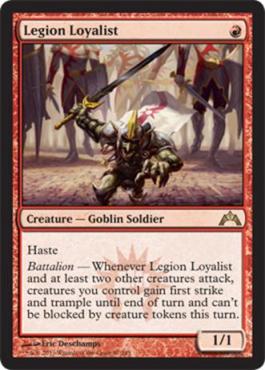
Like every other Goblin card ever printed Legion Loyalist has been suggested as an addition to the Legacy Goblins list by dozens of forum posters. And while Legion Loyalist has a great rate for the effect it generates, this isn’t an effect you really want in your Goblin deck. Giving a bunch of 1 and 2 power guys trample isn’t super effective, nor is the first strike. We may see this guy as a one of sideboard card in Goblins, especially if Goblins swings back to a more aggressive posture in the metagame, but that’s the best I would expect of this card.
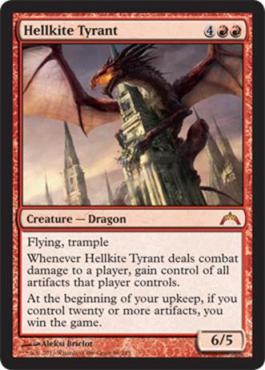
Hellkite Tyrant may see some play in the sideboards of Dredge and Reanimator should the Welder MUD deck have a resurgence. Both Dredge and Reanimator are able to benefit greatly from singleton reanimation targets in the sideboard, as witnessed by the use of Aura Thief a few years ago in Dredge sideboards when Enchantress was on the rise. As far as I can tell Hellkite Tyrant is the best “artifact deck” trump card printed for these types of strategies, and so it has a potential future walk on role.

Skullcrack is probably the second most likely card to see play among these niche players. Like Searing Blaze and Smash to Smithereens, it seems like a viable anti-strategy burn spell that will see sideboard and maybe even maindeck play in mono-red burn. I don’t think red decks have a need to fight lifegain right now, but it’s a good tool to know you have in your arsenal for when you want to sleeve up 21 mountains.

Giant Adephage looks like it might be a good fatty for a Sneak Attack/Natural Order deck, but Worldspine Wurm is miles better than this card and currently sees zero Legacy play.

The obscurely named Pact SI, a RGB storm deck that boasts a low land count, Summoner’s Pact, Diabolic Intent, and Culling the Weak already runs Wild Cantor and would probably welcome the ability to get your mana back and get a warm body to sacrifice to one of its black sorceries in the form of this Gruul Emissary.

Speaking of weird Storm decks, while Whispering Madness doesn’t seem to fit into any of the current Storm decks, a four mana Windfall is probably still strong enough to play in Legacy and therefore may end up turning into a building block of some new Storm combo deck.

Cloudpost decks have occasionally done well in the Star City Games circuit, but they’ve been held back from widespread adoption by the high price tag of Candelabra of Tawnos. The printing of Glimmerpost a couple years ago was a significant addition to this deck, but I’m somewhat skeptical that the clunkiness of Thespian’s Stage isn’t going to be a big enough barrier to adding it to this deck …
Sideboard cards

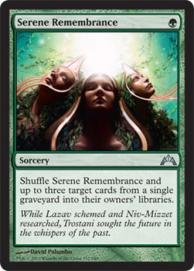

All three of these cards are highly situational and probably too narrow and underpowered to see play in Legacy, but they’re worth mentioning in passing.
- Illness in the Ranks is a potential answer to both Lingering Souls and to Empty the Warrens, but it’s probably worth it to pay the extra two mana to get the versatility of an Engineered Plague.
- Serene Remembrance is pretty low on the power spectrum for graveyard hate cards, but I can imagine there being some iteration of a grindy deck like 43 Lands that might want to maindeck a card like this to have graveyard hate in game 1.
- Shattering Blow is a pretty excellent answer to Painter’s Servant/Grindstone decks (which run Goblin Welder) and to Sword of the Meek/Thopter Foundry decks (which run Academy Ruins). Being a hybrid Red/White spell means that virtually every deck in Legacy can cast it, and while the card lacks the versatility of a Disenchant, it does its job at the best rate available. Neither of these artifact based combos are prevalent in the current Legacy metagame, but if they become relevant in the future this is a valid way to attack them.

 Dimir Charm is a lot like
Dimir Charm is a lot like  Orzhov Charm could see some play in Junk decks if we ever move to a point in the format where a Maverick deck splashing black became a viable choice again. A deck would have to want the third mode to be significantly useful in order to choose to play Orzhov charm, since the first mode is mostly useless and the second mode has to compete with Swords to Plowshares. Realistically the only 1 drops I would be willing to pay 2 mana to reanimate are Deathrite Shaman,
Orzhov Charm could see some play in Junk decks if we ever move to a point in the format where a Maverick deck splashing black became a viable choice again. A deck would have to want the third mode to be significantly useful in order to choose to play Orzhov charm, since the first mode is mostly useless and the second mode has to compete with Swords to Plowshares. Realistically the only 1 drops I would be willing to pay 2 mana to reanimate are Deathrite Shaman, 
















